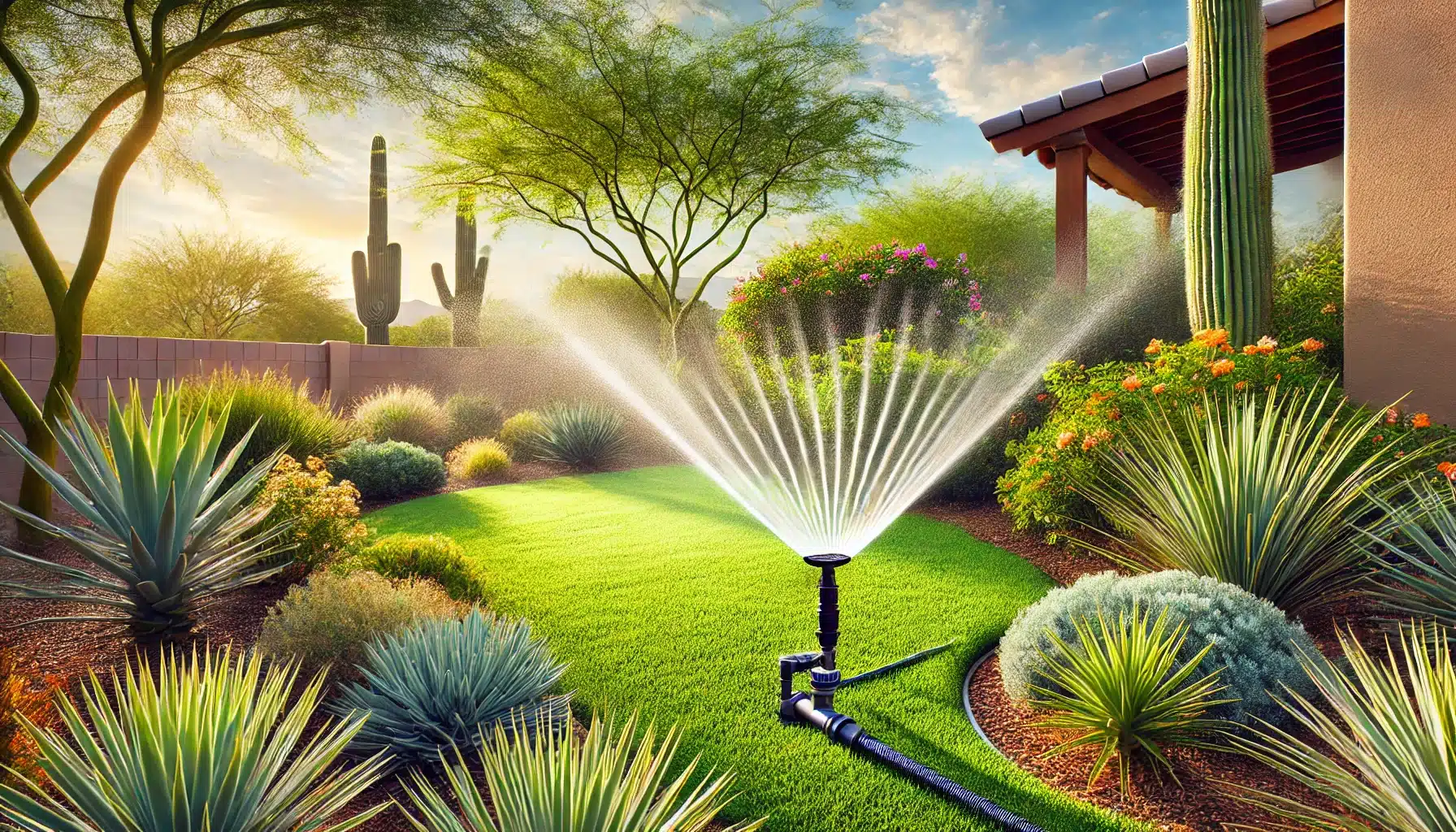A lush, green lawn in the Arizona climate is a beautiful sight and a source of pride for homeowners. However, maintaining such a lawn requires an effective irrigation system tailored to the unique challenges posed by the hot, arid conditions of the region. In this comprehensive guide, we’ll explore different types of irrigation systems, their benefits, and how to choose the best one for your lawn.
Contents
Understanding Your Lawn’s Needs
Before selecting an irrigation system, it’s crucial to understand the specific needs of your lawn. Consider factors such as:
- Soil Type: Sandy, loamy, or clay soils have different water retention capabilities.
- Climate: Arizona’s hot, dry climate means your lawn will require more frequent watering.
- Plant Types: Different plants and grasses have varying water requirements.
- Lawn Size and Shape: The size and layout of your lawn will influence the type of irrigation system you need.
Types of Irrigation Systems
1. Sprinkler Systems
Sprinkler systems are a popular choice for many homeowners due to their versatility and effectiveness in covering large areas.
Advantages:
- Even Coverage: Sprinklers can provide uniform water distribution, ensuring all parts of your lawn receive adequate moisture.
- Automation: Modern sprinkler systems can be automated, allowing you to set specific watering schedules.
- Customization: Sprinkler heads can be adjusted to suit different water pressures and spray patterns.
Considerations:
- Water Efficiency: Sprinklers can be less water-efficient compared to other systems, particularly in windy conditions where water may evaporate or drift.
- Maintenance: Regular maintenance is required to prevent clogging and ensure optimal performance.
2. Drip Irrigation
Drip irrigation is a highly efficient system that delivers water directly to the roots of plants, minimizing evaporation and runoff.
Advantages:
- Water Efficiency: Drip irrigation uses less water compared to sprinkler systems, making it ideal for arid climates.
- Targeted Watering: Water is delivered precisely where it’s needed, reducing wastage.
- Reduced Weed Growth: By delivering water directly to plants, drip irrigation can limit weed growth in other areas of your lawn.
Considerations:
- Installation Costs: Initial installation can be more expensive due to the need for specialized equipment and labor.
- Maintenance: Drip systems require regular monitoring to ensure emitters are not clogged and are functioning correctly.
3. Soaker Hoses
Soaker hoses are a simpler alternative to drip irrigation, providing a cost-effective solution for small to medium-sized lawns.
Advantages:
- Ease of Use: Soaker hoses are easy to install and operate.
- Flexibility: They can be moved and adjusted to accommodate different lawn layouts.
- Affordability: Soaker hoses are generally less expensive than other irrigation systems.
Considerations:
- Water Distribution: Soaker hoses may not provide as uniform water distribution as drip or sprinkler systems.
- Durability: They can be prone to wear and tear, requiring replacement over time.
Factors to Consider When Choosing an Irrigation System
When deciding on the best irrigation system for your lawn, keep the following factors in mind:
Water Efficiency
In Arizona, where water is a precious resource, choosing a water-efficient irrigation system is essential. Drip irrigation and soaker hoses typically use less water than sprinkler systems, making them suitable for conserving water while maintaining a healthy lawn.
Cost
Consider both the initial installation costs and ongoing maintenance expenses. While drip irrigation may have higher upfront costs, its water-saving benefits can lead to long-term savings on your water bill.
Lawn Size and Shape
The size and shape of your lawn will impact the type of irrigation system that is most effective. Sprinkler systems are ideal for larger, open areas, while drip irrigation and soaker hoses work well in smaller, irregularly shaped lawns.
Climate and Soil Conditions
Arizona’s climate and soil conditions play a significant role in determining the best irrigation system. For example, sandy soils drain quickly and may require more frequent watering, while clay soils retain water longer but can become waterlogged if over-irrigated.
Installing Your Irrigation System
Planning and Design
Proper planning and design are crucial for the success of your irrigation system. Consider hiring a professional from Red Mountain Landscaping to assess your lawn and recommend the best system based on your specific needs.
Installation Tips
- Sprinkler Systems: Ensure sprinkler heads are evenly spaced and adjusted to avoid overspray onto sidewalks or driveways.
- Drip Irrigation: Lay out the drip lines close to the root zones of plants and use emitters with appropriate flow rates.
- Soaker Hoses: Place hoses along plant rows or in a serpentine pattern for even coverage.
Maintenance and Troubleshooting
Regular maintenance is essential to keep your irrigation system running efficiently. Here are some tips for maintaining different systems:
Sprinkler Systems
- Check for Leaks: Inspect for leaks or damaged sprinkler heads that could waste water.
- Adjust Timing: Modify watering schedules based on seasonal changes and weather conditions.
- Clean Nozzles: Remove and clean nozzles to prevent clogs and ensure proper spray patterns.
Drip Irrigation
- Monitor Emitters: Check emitters regularly to ensure they are not clogged or damaged.
- Flush Lines: Periodically flush the system to remove debris and prevent blockages.
- Inspect Connections: Ensure all connections are secure to prevent leaks.
Soaker Hoses
- Check for Damage: Inspect hoses for cracks or holes that could lead to uneven watering.
- Adjust Placement: Move hoses as needed to ensure all areas of your lawn receive adequate water.
- Store Properly: Store hoses properly during the off-season to extend their lifespan.
Benefits of Professional Installation and Maintenance
Hiring professionals like those at Red Mountain Landscaping can provide several benefits:
- Expertise: Professionals have the knowledge and experience to design and install efficient irrigation systems tailored to your lawn’s needs.
- Time-Saving: Letting experts handle installation and maintenance saves you time and effort.
- Optimal Performance: Professional installation ensures your system operates at peak efficiency, reducing water waste and promoting a healthier lawn.
Conclusion
Choosing the ideal irrigation system for your lawn in Arizona involves understanding your lawn’s specific needs, evaluating different types of systems, and considering factors such as water efficiency, cost, and climate conditions. Whether you opt for a sprinkler system, drip irrigation, or soaker hoses, proper installation and maintenance are key to achieving a lush, green lawn.
For expert advice and professional installation, consider contacting Red Mountain Landscaping. Request a Free Quote today and take the first step towards a healthier, more beautiful lawn.



